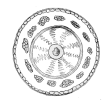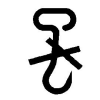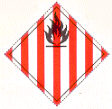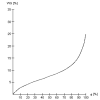| Flax | [German version] |
Table of contents |
|
| General: | ||
| Product information | ||
| Packaging | ||
| Transport | ||
| Container transport | ||
| Cargo securing | ||
Product information
Product name
| German | Flachs, Lein |
| English | Flax |
| French | Lin |
| Spanish | Lino |
| Scientific | Linum usitatissimum |
| CN/HS number * | 5301 ff. |
(* EU Combined Nomenclature/Harmonized System)
Product description
Flax belongs to the category fibers/fibrous materials, which are classified as follows [24]:
Plant hairs:
| Cotton seed-hairs | |
| Kapok tree fruit hairs |
Stalk fibers from dicotyledonous plants (soft fibers):
| Flax, ramie (fine spinnable fibers) | |
| Hemp, jute, kenaf (coarse spinnable fibers) |
Leaf fibers from monocotyledonous plants (hard fibers):
| Sisal, Manila hemp, palm fibers (poor spinning characteristics) |
Bast:
| Linden, raffia palm, willow |
Basketwork material:
| Coconut, rattan cane, halfa, piassava, esparto |
Flax fibers are the retted bast fibers of the flax plant (Linum usitatissimum), which belongs to the Linaceae family and has been cultivated for several millennia. The ancient Egyptians made mummy wrappings from flax, while woven linen fabrics originating from Europe which date from the same period are also known.
The flax plant consists of root, stalk and branches bearing the seed capsules. Only the processable central portion of the stalk is usable for spinning purposes. This central portion is delimited by the cotyledonary node and the bottom of the branches (see Figure 1).
Before the seeds are even ripe, the flax plants are uprooted whole and placed in water (water retting), so separating the fibers from the remainder of the stalk.
A distinction is drawn between cold water retting (10 – 14 days) and hot water retting (a few days at temperatures of up to 35°C). After washing, the flax straw is usually kiln dried. The stalks are bent by intermeshing wooden boards and the fibers removed from the lignified stalks. The crude fibers are combed with hatchels to yield the long spinnable fibers, the short fibers (pluckings or tow) remaining between in the steel teeth of the comb.
Flax fibers are gray to light blond in color, very strong but at the same time also flexible. The fibers may be up to 140 cm in length, but approx. 60 cm is usual.
When a flax stalk is snapped, the flax fibers protrude from the broken ends, each fiber consisting of cells up to 5 cm in length. The sharp ends of the cells interlock and are thus suitable for producing woven linen fabrics.
The chemical composition of flax fibers, relative to dry weight, is as follows:
| Cellulose 71% | |
| Polyoses 18.5% | |
| Pectins, pigments 6.5% | |
| Lignin 2% | |
| Waxes 2% |
Quality / Duration of storage
Flax fibers are among the strongest of fibrous materials.
Flax quality is assessed on the basis of fiber length, fiber strength and purity.
Wet, moist or oil-stained bales must not be accepted.
Subject to compliance with the appropriate temperature and humidity/moisture conditions, duration of storage is not a limiting factor as regards transport and storage life.
Intended use
Flax is used to produce high quality textile fibers as well as sacking fabrics, dressing materials, tarpaulins, yarns and ropes. Due to their high strength, linen yarns and woven fabrics are suitable not only for bedding and table linen, but also for sewing threads, bookbinding fabrics and heavy woven fabrics (tarpaulin fabrics, sports mats), rucksack fabrics, working clothes, hospital linen and tropical clothing.
Flax nonwovens are used in the production of insulating sheets for house building.
Figure
(Click on the individual Figures to enlarge them.)
Figure 1 |
Figure 2 |
 Figure 3 |
 Figure 4 |
Countries of origin
This Table shows only a selection of the most important countries of origin and should not be thought of as exhaustive.
| Europe | Belgium, Ireland, Netherlands, Romania, Russia, Hungary, Poland, France, Italy |
| Africa | Egypt |
| Asia | India |
| America | USA, Argentina |
| Australia | Australia, New Zealand |
Back to beginning
Packaging
Flax is wound in hanks or stricks and shipped as bales. Bales vary weight between 150 and 204 kg depending on country of origin. Some bales from the USA even weigh as much as 290 kg. The bales are shipped in compressed and uncompressed form, with compression not being so tight as for cotton in order to protect the fibers. The bales are strapped with steel strapping to ensure that they hold together better.
| Marking of packages | ||
 Keep dry |
 Use no hooks |
 Keep away from heat (solar radiation) |
Back to beginning
Transport
Symbols
 Spontaneously combustible, Class 4.2 IMDG Code |
 Fire hazard (Flammable solids), Class 4.1 IMDG Code |
 General cargo |
Means of transport
Ship, truck, railroad
Container transport
Standard containers , subject to compliance with water content of goods and flooring.
Cargo handling
In damp weather (rain, snow), the cargo must be protected from moisture, since flax is strongly hygroscopic and readily absorbs moisture. This may lead to discoloration, decay, staining, a musty odor and rusted steel strapping.
Do not use hooks for cargo handling, since they may lead to sparking when they come into contact with the strapping. In addition, smoking is absolutely prohibited during cargo handling.
Stowage factor
| 2.60 – 2.83 m3/t (bales) [1] | |
| 2.37 – 3.62 m3/t (bales) [11] | |
| 2.55 – 4.53 m3/t [14] |
Stowage space requirements
Cool, dry
Segregation
Fiber rope, thin fiber nets
Cargo securing
The cargo is to be secured in such a way that the bales or strapping are not damaged. Undamaged strapping is essential to maintain compression of the bales during transport. If the strapping is broken, compression is diminished, which at the same time results in an increased supply of oxygen to the inside of the bales. This in turn increases the risk of combustion or feeds a fire which has already started. Bursting or chafing of steel strapping may lead to sparking and external ignition.
Back to beginning
Risk factors and loss prevention
RF Temperature
Flax requires particular temperature, humidity/moisture and possibly ventilation conditions (SC VI) (storage climate conditions).
Favorable travel temperature range: no lower limit – 25°C
Every hold should be equipped with means for measuring temperature. Measurements must be performed and recorded daily.
Flax must be stowed away from heat sources.
Back to beginning
RF Humidity/Moisture
Flax requires particular temperature, humidity/moisture and possibly ventilation conditions (SC VI) (storage climate conditions).
| Designation | Humidity/water content | Source |
| Relative humidity | 65% | [1] |
| Water content | 10 – 12% | [1] |
| 12% | [14] | |
| Maximum equilibrium moisture content | 65% | [1] |
Flax behaves strongly hygroscopically (hygroscopicity). At a water content of 10%, flax is at equilibrium with 70% relative humidity. It must be protected from sea, rain and condensation water and also from high levels of relative humidity, if discoloration, staining and a musty odor are to be avoided. In the event of severe exposure, decay occurs which consequently impairs the tensile strength of the fibers.
 Figure 5 |
Flax is less rot-resistant than cotton. In addition, it may swell by absorbing water vapor, resulting in an increase in volume of approx. 20%. An elevated water content is difficult to identify from external signs.
Moisture measurements are recommended prior to loading. Moisture-damaged bales must not be accepted.
Back to beginning
RF Ventilation
Flax requires particular temperature, humidity/moisture and possibly ventilation conditions (SC VI) (storage climate conditions).
If the product is loaded for shipment in a dry state, it does not have any particular ventilation requirements.
Problems arise if the product, packaging and/or ceiling/flooring are too damp. In this case, the following ventilation measures should be implemented:
Air exchange rate: 10 changes/hour (airing)
Moisture must constantly be eliminated, to reduce mold and bacterial activity.
Since flax very readily absorbs oxygen, before anybody enters the hold, it must be ventilated and a gas measurement carried out, since a shortage of oxygen may endanger life.
Back to beginning
RF Biotic activity
Flax displays 3rd order biotic activity.
It belongs to the class of goods in which respiration processes are suspended, but in which biochemical, microbial and other decomposition processes still proceed.
Back to beginning
RF Gases
Flax very readily absorbs oxygen. An oxygen shortage may therefore arise in closed holds and containers. Before anybody enters such holds, the holds must be ventilated and, if necessary, a gas measurement carried out.
An increase in CO2 and CO content indicates a cargo fire. The TLV of the hold air is 0.49 vol.%. As a result of the oxygen-rich lumen, bales often burn for weeks without being discovered.
Back to beginning
RF Self-heating / Spontaneous combustion
Flax has an oil content of 1 – 2% (waxes).
Flax is assigned to Class 4.1 of the IMDG Code (Flammable solids). However, its specific characteristics and negative external influences (see below) may cause it to behave like a substance from Class 4.2 (Substances liable to spontaneous combustion) of the IMDG Code or ADR.
Its high cellulose content makes flax particularly liable to catch fire through external ignition. Therefore, it must always be protected from sparks, fire, naked lights and lit cigarettes. Smoking is absolutely prohibited. Sparks may arise from bursting or chafing of the steel straps (and also as a result of inadequate cargo securing in the hold or container) and cause a cargo fire. In accordance with the IMDG Code, ventilation openings leading into the hold should be provided with spark-proof wire cloth.
Spontaneous combustion may occur as a result of exposure to moisture, animal and vegetable fats/oils, oil-bearing seeds/fruits, copra and raw wool. As a result of the very well developed oxygen-rich lumen of the flax fiber and the oxygen supply contained in the capillary cavity system, smoldering fires inside the bales often last for weeks.
Fire-fighting is best performed using CO2 . It is very difficult to extinguish a fire because of the excess of oxygen in the flax fiber, which maintains the fire from the inside. When fighting a fire, do not break the steel straps or open the bales, since relieving the compression increases the oxygen supply and makes it impossible to fight the fire effectively.
Water must not be used for fire-fighting, since the swelling capacity of the flax fibers (20% increase in volume) may cause damage to the hold or container walls.
Back to beginning
RF Odor
| Active behavior | Flax has a slight, unpleasant odor. A conspicuous musty odor indicates mold growth inside the bales. |
| Passive behavior | Flax is sensitive to unpleasant or pungent odors. |
Back to beginning
RF Contamination
| Active behavior | Flax does not cause contamination. |
| Passive behavior | Flax is sensitive to contamination by dust, dirt, fats/oils and rust as well as oil-containing goods, such as oil-bearing seeds/fruits, copra, raw wool etc., since oil-impregnated fibers promote self-heating/cargo fire. Increased contamination of flax provides microorganisms with an excellent nutrient medium, which means that holds or containers must be suitably clean and in a thoroughly hygienic condition. Residues from previous cargoes, such as ores, stones, coal, metal filings, fertilizers etc., result in losses. Rust contamination may be caused by rusty steel straps or wires, among other things. Since rust hampers the spinning process, this represents a reduction in value. |
Back to beginning
RF Mechanical influences
Care must be taken to ensure that mechanical influences do not cause damage to strapping, which increases the risk of fire by relieving the compression of the bale and allowing a greater supply of oxygen. Use no hooks.
Back to beginning
RF Toxicity / Hazards to health
Since flax is highly oxygen-absorbent, a life-threatening shortage of oxygen may arise in the hold or container. Thus, before anybody enters the hold, it must be ventilated and, if necessary, a gas measurement carried out. The TLV for CO2 concentration is 0.49 vol.%.
Back to beginning
RF Shrinkage/Shortage
Unclearly marked bales may result in losses of volume due to incorrect delivery.
Back to beginning
RF Insect infestation / Diseases
Insects, in particular ants and beetles, may damage the bales during storage ashore.
Flax is highly susceptible to attack by fungi and bacteria. This is why tarpaulin fabrics are provided with fungicidal and bactericidal finishes.
Back to beginning
